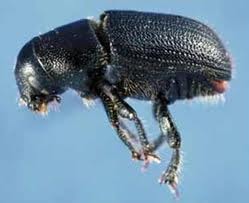Introduction
Black turpentine beetle (Dendroctonus terebrans) is a pine bark beetle that is native to the United States. It is the largest pine bark beetle in the southern part of its range. Black turpentine beetle is typically a secondary pest of vulnerable trees. It colonizes freshly cut stumps, and trees stressed by environmental factors. Dense populations are capable of killing infested trees. The most severe infestations tend to occur in the southeastern United States.
Distribution & Habitat
Black turpentine beetle’s overall distribution corresponds with the range of its hosts. It has been reported from New England, south to Florida, and west to Missouri, Arkansas, and eastern Texas.
Hosts
All southern pines are potential hosts. The insect is most partial to slash pine, loblolly pine, shortleaf pine, and longleaf pine. Black pine, pitch pine, Scots pine, and red spruce may also be infested, albeit with less frequency. Trees that have incurred fire damage, or are suffering from environmental stressors such as drought or flooding are more vulnerable to infestation.
Description
Black turpentine beetle passes through four stages during its life cycle: an egg stage, a larval stage, a pupal stage, and an adult stage. The eggs are laid in galleries that measure 1 to 12 inches long. The larvae are white, with a reddish-brown head. They are grub-like, and lack legs. The larvae can grow up to 12 mm in length. The pupa are white in coloration, and similar in size to the adults. The adults are large beetles. They are initially light tan, but turn black or a deep red within a few days. The beetles have a stout, cylindrical shape. They generally reach 5 to 8 mm in length. The abdomen is bereft of spines, and the pronotum is narrower on the anterior than the posterior. A pair of clubbed antennae protrude outward from the head.
Life Cycle
Beetle infestations are generally confined to the base of susceptible trees. However, the adults may also bore into the root collar if the root system has been extensively damaged. The adults penetrate through the bark and phloem until they have reached the sapwood. This causes resin to flow, and induces the formation of a pitch tube on the bark surface. The pitch tubes are composed of pitch, frass, and bark borings. They typically measure around 1 inch in diameter. Each pitch tube has a large hole in the center. The females lay eggs in galleries in the entrance holes of the pitch tubes.
The eggs hatch in 10 to 14 days, revealing masses of larvae. The larvae are communal feeders. They feast in groups, consuming large portions of the inner bark. As they feed, the larvae progress through four instars. As they approach maturity, the larvae begin to construct pupal cells between the bark and wood layers. The larvae will often backtrack during their feeding, widening the pupal cells. Upon reaching maturation, the larvae settle within the cells, and commence pupation. Within 10 to 14 days, the pupae morph into adults.
The adults vacate the cells, and bore out of the tree. They subsequently navigate to vulnerable stumps or live trees to create a new generation. The females secrete a pheremone, which the males use to locate them. Once the males have navigated to the females, the adults mate. The females begin the egg laying process shortly thereafter. The adults can live for 3 to 4 months, depending on the geographic location. In milder areas, multiple generations may be produced. In regions that experience cold winters, the adults will not emerge until temperatures have increased the following spring.
Symptoms of Infestation
The most conspicuous symptom of infestation is the large pitch tubes that arise due to the insect’s feeding. The pitch tubes will appear on the bark surface of infested trees. At first, the pitch tubes are red to white in coloration. As the pitch tubes age, they turn gray. White sawdust may be observed accumulating around the trunk of infested trees. Trees that are killed will shed their needles. About two months prior to being cast, the needles will fade in color, turning from a yellowish-green to a reddish-brown. Heavily infested trees are often attacked by ambrosia beetles.
Management
- Abundant rainfall may decimate larvae populations.
- When other insects, such as engraver beetles, pine borers, weevils, or termites are present, the larvae may starve.
- Infested trees may be treated with horticultural oils. While this may not eliminate the insects altogether, it can drastically reduce beetle populations. To increase the efficacy of the oils, ensure that the trunk is thoroughly drenched.
- Insecticides registered for use on black turpentine beetle can be utilized to provide some control. Applications should be performed before the adults have infiltrated the bark. Multiple applications may be required for sufficient control in warmer locations.
- As the adults bore into the bark, they may be smothered by the ensuing pitch flow.
Photo courtesy of National Arborists
